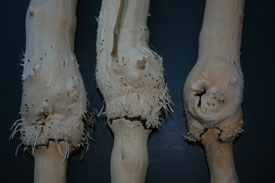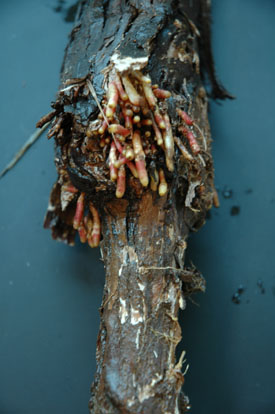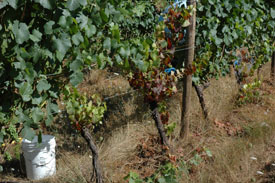Symptoms Management Options Causes More information
Stephen Jordan, University of Wisconsin-Madison
Effects of ringspot virus. From L to R, graft union necrosis, aerial rooting, and in the vineyard. Photos by Bob Martin, USDA-ARS.
Symptoms
Grapevines affected by Ringspot Virus Decline show shortened internodes with small, distorted leaves that are approximately one third the size of a healthy leaf. Other leaf symptoms include yellow line patterns and flecks along veins, and in some cases, distortion can occur producing an oak-leaf pattern. Berry cluster set is reduced, and clusters often have uneven ripening. In the first year of infection, detection is often difficult. In the second year, shoot growth is limited, because buds arising from infected tissue are more susceptible to winterkill. By the third year, growth is limited to suckers located near the base of the trunk and all new growth is stunted. The vine eventually dies. This disease occurs sporadically in Vitis vinifera grapes (e.g., ‘Chardonnay’, ‘Cabernet Sauvignon’, ‘Riesling’) and interspecific hybrids (e.g., ‘Vidal Blanc’, ‘Marechel Foch’). Vitis labrusca grapes (e.g., ‘Niagara’, ‘Delaware’) are resistant. The symptoms can differ significantly in different geographical regions, typically with greater severity in colder regions due to reduced cold hardiness of buds. The disease also has several other common names, such as “little grape” and “grape yellow vein”.
Cultural Management Options
- Plant healthy stock. Use planting material that is certified free of ringspot viruses. Clones of most rootstocks and cultivars that have been tested and found to be free of all known viruses are available.
- Use nematode and virus resistant rootstocks, especially in areas with a history of ringspot virus decline.
- For new vineyards, work the ground one year in advance of planting and maintain good weed control throughout the life of the vineyard, as weeds serve as potential reservoirs of the ringspot viruses.
- There is no way to cure an infected vine. Remove and destroy virus infected vines including nearby healthy vines, as they are likely to be infected.
Chemical Management Options
Currently, there are no chemical control options for ringspot virus decline. The use of a nematicide can delay onset of the disease in re-plant and at-risk vineyards.
Causes
Ringspot virus decline is caused by either of two nepoviruses: tomato ringspot virus (TomRSV), or tobacco ringspot virus (TMRV), both of which are transmitted by dagger nematodes (Xiphinema spp.), and via seeds and cuttings. The nematodes acquire the virus from feeding on infected roots of grape or weed species. The nematode vectors retain the virus for long periods of time. Both TomRSV and TRSV can infect many common weeds in vineyards, including dandelions, sheep sorrel, common chickweed, and red clover. Because of this, it is not uncommon for these viruses to be present on land used to establish new vineyards. While TomRSV and TMRV can produce disease symptoms in grapevine that are identical, there are some important differences between the two. TomRSV infects a wide range of fruit crops and is considered one of the most economically important viruses infecting fruit crops in the northeastern United States, whereas TMRV does not infect other deciduous fruit crops. TMRV is also a more common problem in Vitis vinifera grapes.
Recommended Resources
Grapevine Decline in Pennsylvania & New York, Pennsylvania State University
UC-Davis Plant Virus Information
Grape Disease Management Overview
Reviewed by Damon Smith, Oklahoma State University and Michelle Moyer, Washington State University



